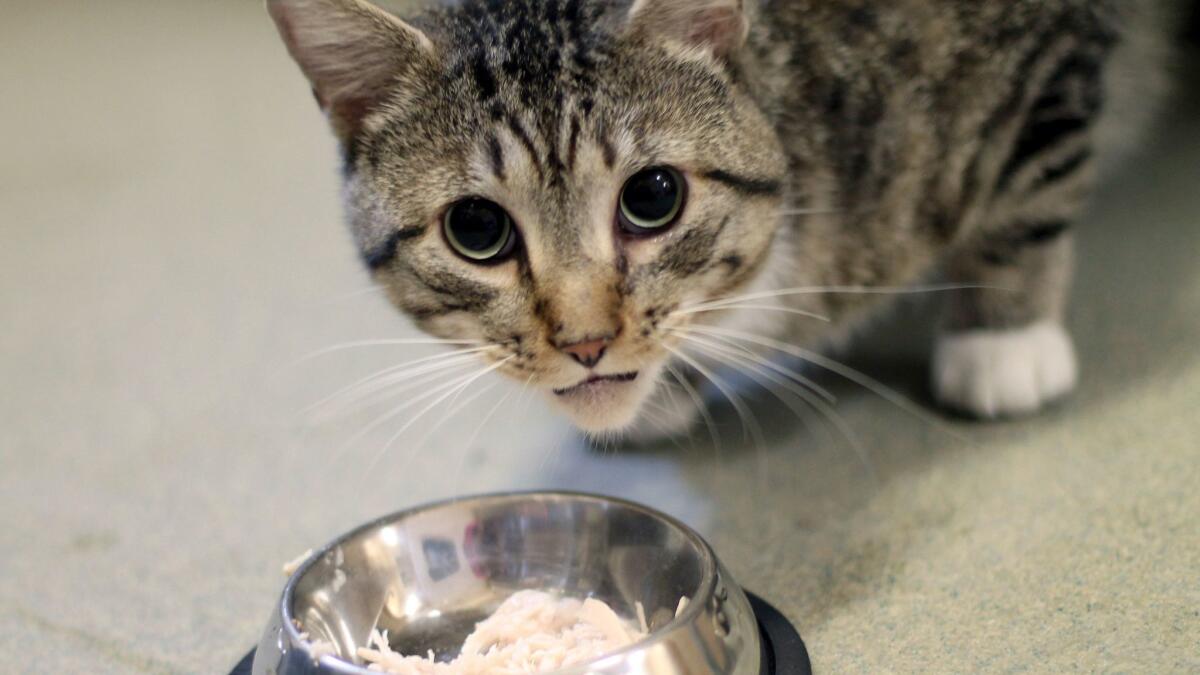Scientists tally the environmental impact of feeding meat to our cats and dogs. It’s huge
- Share via
You’ve heard about the carbon footprint, but what about the carbon paw-print? According to a new study, U.S. cats’ and dogs’ eating patterns have as big an effect as driving 13.6 million cars for a year.
The findings, published in the journal PLOS One, reveals how our furry, four-legged companions’ consumption of meat and other animal products adds a sizable, and largely overlooked, climate cost.
When it comes to environmental effects, meat-eating takes the cake. A 2014 study in the Proceedings of the National Academy of Sciences found that producing a kilogram of chicken results in about 3.7 kilograms of carbon dioxide, while a kilogram of pork comes with 24 kilograms of carbon dioxide. The same amount of beef, however, can be responsible for up to 1,000 kilograms of CO2 — a worrisome figure given that this greenhouse gas is largely responsible for the significant warming of the Earth’s climate. That’s not even counting the livestock’s water usage footprint, which dwarfs that of agricultural crops.
It’s a growing concern given that developed countries such as the U.S. consume lots of animal protein, and that developing countries that are economically on the rise seem to be increasing their share of meat consumption too.
But one sleepless night about five years ago, UCLA geographer Gregory Okin realized something: Those environmental assessments rarely if ever took into account the consumption by dogs and cats. The thought gave him pause — perhaps even paws.
“Because I couldn’t sleep, I got up and just kind of started throwing some numbers together,” he said. “It’s evolved a lot since then.”
He calculated the likely number of calories needed by the United States’ pet dogs and cats, who number around 163 million, and examined the ingredients in pet food and tallied up which ones were derived from animals.
The results? Cats’ and dogs’ overall caloric consumption was about 19% that of humans in the U.S.
“Just to put that in context, that’s about the same amount of calories that the country of France consumes and so that whet my appetite a little bit,” Okin said.

Notably, dogs and cats actually consumed about 33% of the animal-derived calories that humans did, perhaps because their diets are generally more meat-heavy than ours, Okin said. On the other end, they also produce about 30% of the feces that humans do (and much of that gets thrown in the trash in plastic bags, instead of treated the way that human waste is).
In short, Okin concluded, American dogs and cats eat enough animal product to account for about 64 million tons of methane and nitrous oxide, two other powerful greenhouse gases. That’s about the same impact on our warming climate as driving 13.6 million cars for a year.
“Americans are the largest pet owners in the world, but the tradition of pet ownership in the U.S. has considerable costs,” Okin wrote in the paper. “As pet ownership increases in some developing countries, especially China, and trends continue in pet food toward higher content and quality of meat, globally, pet ownership will compound the environmental impacts of human dietary choices.”
Okin stressed that he wasn’t advocating giving up beloved furry friends — far from it. But for people who want to be aware of their environmental impact so that they can try to reduce it, it’s probably worth knowing the full effect of their household, canines and felines included.
There’s also a movement toward putting more meat in pet foods, perhaps driven by what Okin called the “humanization” of pet products. But dogs aren’t pure carnivores. They’re omnivorous, having developed the ability to readily digest starches — possibly from the trash heaps that accumulated around ancient human encampments. So dogs, at least, could potentially get even more of their required protein from non-animal sources than pet owners may commonly think.
“I certainly hope these kinds of numbers will encourage the market to consider adding those as market choices, and I also think that individuals can make choices,” Okin said.

Follow @aminawrite on Twitter for more science news and “like” Los Angeles Times Science & Health on Facebook.
MORE IN SCIENCE
Scientists find key ‘friendliness’ genes that distinguish dogs from wolves
Science proves it: Money really can buy happiness







